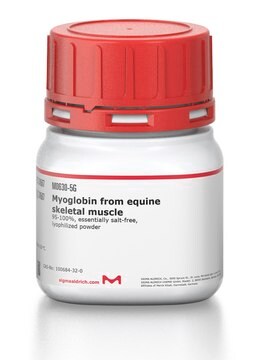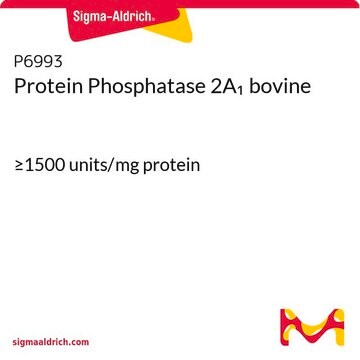506123
Anti-p38 MAP Kinase (341-360) Rabbit pAb
liquid, Calbiochem®
Sign Into View Organizational & Contract Pricing
All Photos(1)
About This Item
UNSPSC Code:
12352203
Recommended Products
biological source
rabbit
Quality Level
antibody form
affinity isolated antibody
antibody product type
primary antibodies
clone
polyclonal
form
liquid
does not contain
preservative
species reactivity
mouse, rat, human
manufacturer/tradename
Calbiochem®
storage condition
OK to freeze
avoid repeated freeze/thaw cycles
isotype
IgG
shipped in
wet ice
storage temp.
−20°C
target post-translational modification
unmodified
Gene Information
mouse ... Mapk11(19094)
General description
Protein A and immunoaffinity purified rabbit polyclonal antibody. Recognizes the ~38 kDa p38 MAPK protein.
Recognizes the ~38 kDa p38 MAPK protein.Antibody Target Gene Symbol: MAPK14 Target Synonym: CRK1, CSBP, CSBP1, CSBP2, CSPB1, EXIP, Hog, MAPK p38, MGC102436, MGC105413, MXI2, P38, P38 KINASE, P38 Map Kinase, p38 Mapk alpha, P38-ALPHA, p38-RK, p38/Hog1, p38/Mpk2, P38/RK, p38a, p38Hog, p38MAPK, PRKM14, PRKM15, RK, SAPK2A Entrez Gene Name: mitogen-activated protein kinase 14 Hu Entrez ID: 1432 Mu Entrez ID: 26416 Rat Entrez ID: 81649
This Anti-p38 MAP Kinase (341-360) Rabbit pAb is validated for use in Flow Cytometry, Immunoblotting, Paraffin Sections for the detection of p38 MAP Kinase (341-360).
Immunogen
Human
a synthetic peptide (TYDEYISFVPPPLDQEEMES) corresponding to amino acids 341-360 of human p38 MAP kinase
Application
Flow Cytometry (1:25)
Immunoblotting (1:1000)
Paraffin Sections (1:50, heat pretreatment required, see comments)
Immunoblotting (1:1000)
Paraffin Sections (1:50, heat pretreatment required, see comments)
Warning
Toxicity: Standard Handling (A)
Physical form
In 150 mM NaCl, 10 mM HEPES, 50% glycerol, 0.01% BSA, pH 7.5.
Reconstitution
Following initial thaw, aliquot and freeze (-20°C).
Other Notes
Pretreat paraffin sections by heating tissue in 10 mM citrate buffer, pH 6.0 for 1 min at high power followed by 9 min at medium power; keep the slides fully immersed and maintain the temperature at or just below boiling; cool the slides for 20 min at room temperature prior to staining. Variables associated with assay conditions will dictate the proper working dilution.
Recommended Protocol for Immunoblotting
Solutions and Reagents
• Transfer Buffer: 25 mM Tris base, 0.2 M glycine, 20% methanol, pH 8.5.
• SDS Sample Buffer: 62.5 mM Tris-HCl, pH 6.8, 2% SDS, 10% glycerol, 50 mM DTT, 0.1% bromophenol blue.
• 10X TBS (Tris-buffered saline): To prepare 1 liter, 24.2 g Tris base, 80 g NaCl, adjust pH to 7.6 with HCl. Dilute 1:10 for use.
• Blocking Buffer: 1X TBS, 0.1% Tween®-20 detergent with 5% non-fat dry milk.
• Primary Antibody Dilution Buffer: 1X TBS, 0.1% Tween-20 detergent with 5% BSA
• Wash Buffer (TBST): 1X TBS, 0.1% Tween-20 detergent
Blotting Membrane
Nitrocellulose or PVDF membranes may be used.
Protein Blotting
1. Lyse cells by adding 100 ml SDS Sample Buffer and immediately scrape the cells off the plate and transfer the extract to a microfuge tube. Keep on ice.
2. Sonicate for 2 s to shear DNA and reduce sample viscosity.
3. Heat sample to 95-100°C for 5 min. Cool on ice.
4. Microcentrifuge for 5 min.
5. Load 20 ml onto SDS-PAGE gel (10 cm x 10 cm).
6. Electrotransfer to nitrocellulose membrane.
As controls, we recommend using 15 ml of phosphorylated and nonphosphorylated C-6 glioma cell extracts.
Membrane Blocking, Gel and Antibody Incubations
1. After transfer, wash membrane with 25 ml TBS for 5 min at room temperature.
2. Incubate membrane in 25 ml of Blocking Buffer for 1-3 h at room temperature or overnight at 4°C.
3. Wash 3 times for 5 min each with 15 ml TBST.
4. Incubate membrane and primary antibody (at the appropriate dilution) in 10 ml Primary Antibody Dilution Buffer with gentle agitation overnight at 4°C.
5. Wash 3 times for 5 min each with 15 ml TBST.
6. Incubate membrane with conjugated secondary antibody at the appropriate dilution in 10 ml Blocking Buffer with gentle agitation for 1 h at room temperature.
7. Wash membrane as in step 5.
Detection of Proteins
Chemiluminescence.
Recommended Protocol for Immunoblotting
Solutions and Reagents
• Transfer Buffer: 25 mM Tris base, 0.2 M glycine, 20% methanol, pH 8.5.
• SDS Sample Buffer: 62.5 mM Tris-HCl, pH 6.8, 2% SDS, 10% glycerol, 50 mM DTT, 0.1% bromophenol blue.
• 10X TBS (Tris-buffered saline): To prepare 1 liter, 24.2 g Tris base, 80 g NaCl, adjust pH to 7.6 with HCl. Dilute 1:10 for use.
• Blocking Buffer: 1X TBS, 0.1% Tween®-20 detergent with 5% non-fat dry milk.
• Primary Antibody Dilution Buffer: 1X TBS, 0.1% Tween-20 detergent with 5% BSA
• Wash Buffer (TBST): 1X TBS, 0.1% Tween-20 detergent
Blotting Membrane
Nitrocellulose or PVDF membranes may be used.
Protein Blotting
1. Lyse cells by adding 100 ml SDS Sample Buffer and immediately scrape the cells off the plate and transfer the extract to a microfuge tube. Keep on ice.
2. Sonicate for 2 s to shear DNA and reduce sample viscosity.
3. Heat sample to 95-100°C for 5 min. Cool on ice.
4. Microcentrifuge for 5 min.
5. Load 20 ml onto SDS-PAGE gel (10 cm x 10 cm).
6. Electrotransfer to nitrocellulose membrane.
As controls, we recommend using 15 ml of phosphorylated and nonphosphorylated C-6 glioma cell extracts.
Membrane Blocking, Gel and Antibody Incubations
1. After transfer, wash membrane with 25 ml TBS for 5 min at room temperature.
2. Incubate membrane in 25 ml of Blocking Buffer for 1-3 h at room temperature or overnight at 4°C.
3. Wash 3 times for 5 min each with 15 ml TBST.
4. Incubate membrane and primary antibody (at the appropriate dilution) in 10 ml Primary Antibody Dilution Buffer with gentle agitation overnight at 4°C.
5. Wash 3 times for 5 min each with 15 ml TBST.
6. Incubate membrane with conjugated secondary antibody at the appropriate dilution in 10 ml Blocking Buffer with gentle agitation for 1 h at room temperature.
7. Wash membrane as in step 5.
Detection of Proteins
Chemiluminescence.
Raingeaud, J., et al. 1995. J. Biol. Chem.270, 7420.
Zervos, A.S., et al. 1995. Proc. Natl. Acad. Sci. USA92, 10531.
Han, J., et al. 1994. Science265, 808.
Lee, J.C., et al. 1994. Nature372, 739.
Rouse, J., et al. 1994. Cell78, 1027.
Zervos, A.S., et al. 1995. Proc. Natl. Acad. Sci. USA92, 10531.
Han, J., et al. 1994. Science265, 808.
Lee, J.C., et al. 1994. Nature372, 739.
Rouse, J., et al. 1994. Cell78, 1027.
Legal Information
CALBIOCHEM is a registered trademark of Merck KGaA, Darmstadt, Germany
TWEEN is a registered trademark of Croda International PLC
Not finding the right product?
Try our Product Selector Tool.
Storage Class
10 - Combustible liquids
wgk_germany
WGK 1
Certificates of Analysis (COA)
Search for Certificates of Analysis (COA) by entering the products Lot/Batch Number. Lot and Batch Numbers can be found on a product’s label following the words ‘Lot’ or ‘Batch’.
Already Own This Product?
Find documentation for the products that you have recently purchased in the Document Library.
Norika Mengchia Liu et al.
Journal of molecular medicine (Berlin, Germany), 95(3), 335-348 (2016-12-23)
Restenosis after angioplasty is a serious clinical problem that can result in re-occlusion of the coronary artery. Although current drug-eluting stents have proved to be more effective in reducing restenosis, they have drawbacks of inhibiting reendothelialization to promote thrombosis. New
Miriam S Giambelluca et al.
Journal of leukocyte biology, 102(3), 829-836 (2017-02-10)
Activation of the adenosine 2A receptor (A2AR) elevates intracellular levels of cAMP and acts as a physiologic inhibitor of inflammatory neutrophil functions. In this study, we looked into the impact of A2AR engagement on early phosphorylation events. Neutrophils were stimulated
Our team of scientists has experience in all areas of research including Life Science, Material Science, Chemical Synthesis, Chromatography, Analytical and many others.
Contact Technical Service




